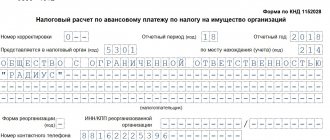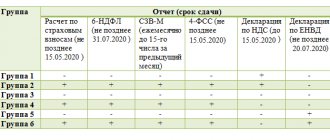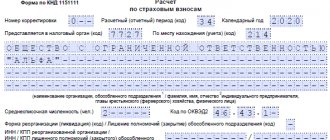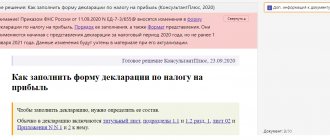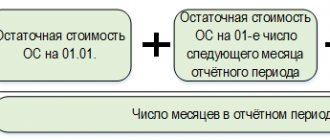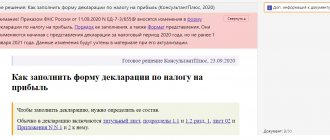Taxes and fees
Denis Pokshan
Expert in taxes, accounting and personnel records
Current as of October 1, 2018
Calculation of the advance payment for property tax for the 3rd quarter of 2018 is submitted by all payers of this tax, except beneficiaries. How to make the calculation correctly and submit it so that the tax authorities do not have any questions - we will study in this article.
General rules for calculating property tax advances
The procedure for calculating and paying property tax for organizations is regulated by Chapter 30 of the Tax Code of the Russian Federation.
In general, the object of taxation is movable and immovable property, recorded on the balance sheet as fixed assets.
The tax period is the calendar year, and the reporting period is periods that are multiples of a quarter.
Before you begin calculating your advance property tax payment for the 3rd quarter of 2021, you should do the following:
- Check whether you need to make this calculation at all. The Tax Code gives the authorities of the constituent entities of the Russian Federation the right to cancel advance payments for property tax both in the region as a whole and for certain categories of taxpayers (clause 3 of Article 379, clause 6 of Article 382 of the Tax Code of the Russian Federation).
- Specify the category of property. For some types of objects, the tax base is determined in a special manner (based on cadastral value).
- Consider the location of objects. If they are located in territories under the jurisdiction of different Federal Tax Service Inspectors, then they should be “segregated” into different reports.
Also see “Calculation of advance payment on property for 2 sq.m. 2021."
General provisions
Companies are required to report on “interim” payments 3 times a year - for 3, 6 and 9 months. The deadline for submitting the form is the 30th day of the month following the reporting period.
Before filling out the calculation, you should find out a number of important nuances:
- the need to submit it in principle, since regional authorities have the right to cancel advances on property taxes on their territory;
- the rate in your region, which is set by the authorities of the subject;
- availability of tax incentives, which allows you to reduce the amount of tax;
- category of property: the method of calculating tax depends on this - by residual or cadastral value;
- cadastral numbers of taxable objects - by their first digits you can understand which territorial inspection the form should be sent to.
Calculation of advance payments for property tax depending on the category of objects
The procedure for calculating property tax based on the cadastral value is determined by Art. 378.2 Tax Code of the Russian Federation. This method is used to calculate tax for the following objects:
- Business or shopping centers (complexes) and premises inside them. These objects must satisfy the following conditions:
– the permitted use of the land plot under the building involves the placement of office buildings or retail facilities;
– at least 20% of the building’s area must have permitted use as office or retail premises, public catering and consumer services, or actually be used for these purposes.
- Separate non-residential premises that are permitted to be used for offices, trade, consumer services or public catering, or that are actually used for these purposes.
- Real estate objects of foreign organizations not related to work through permanent representative offices.
- Residential buildings and premises that are not included on the balance sheet as fixed assets.
A specific list of “office” and “retail” objects for which property tax is calculated on the basis of cadastral value is determined by the regional authorities at the beginning of each tax period (clause 7 of Article 378.2 of the Tax Code of the Russian Federation).
The advance payment of property tax for the 3rd quarter of 2018 in relation to such objects is determined as 1/4 of their total cadastral value as of 01/01/2018, multiplied by the corresponding tax rate (clause 1, clause 12, article 378.2 of the Tax Code of the Russian Federation).
The tax base for all other taxable objects, except for “cadastral” ones, is determined on the basis of their value according to accounting data. The base for 9 months of 2021 is calculated as the sum of the values of the residual value at the beginning of each month, from January to October, divided by 10. The amount of the advance payment will be equal to ¼ of the product of the tax base by the rate established for this category of objects (clause 4 of Art. 382 of the Tax Code of the Russian Federation).
Example.
Alpha LLC owns office space. Its cadastral value at the beginning of 2021 is KS = 10,000 thousand rubles. The residual value of other objects subject to property tax for 9 months of 2021 was:
| date | Residual value, thousand rubles. |
| 01.01.18 | 5 000 |
| 01.02.18 | 4 900 |
| 01.03.18 | 4 800 |
| 01.04.18 | 4 700 |
| 01.05.18 | 4 600 |
| 01.06.18 | 4 500 |
| 01.07.18 | 4 400 |
| 01.08.18 | 4 300 |
| 01.09.18 | 4 200 |
| 01.10.18 | 4 100 |
The tax rate for objects taxed at cadastral value is C1 = 1.5%, for other taxable property – C2 = 2.2%. The company does not benefit from property tax benefits.
The advance payment for the 3rd quarter of 2021 for “cadastral” objects will be:
APk = ¼ x KS x C1 = ¼ x 10,000 x 1.5% = 37.5 thousand rubles.
Advance payment on objects taxed at average cost:
APs = ¼ x SS x C2,
where CC is the average residual value of objects for the period
CC = (5,000 + 4,900 + 4,800 + 4,700 + 4,600 + 4,500 + 4,400 + 4,300 + 4,200 + 4,100) /10 = 4,550 thousand rubles.
APs = ¼ x 4,550 x 2.2% = 25.025 thousand rubles.
The total amount of the advance payment of Alpha LLC for property tax for the 3rd quarter of 2021 will be:
AP = APk + APs = 37.5 + 25.025 = 62.525 thousand rubles.
A sample of filling out the calculation based on the example data can be downloaded here.
Determination of the tax base
The tax is calculated according to the residual value (Section 2 of the form) or according to the cadastral value (Section 3). We'll look at what this depends on next.
The principle is the same in both cases: the value of the property is multiplied by the tax rate and divided by 4 (by the number of quarters). However, tax bases are calculated differently.
In Sect. 2 for the 3rd quarter of 2021, indicate the residual value of the objects as of the first day of each month, including October 1. Next, calculate the average property value over 10 months. This amount will be the tax base for calculating advances.
Moreover, it can be reduced if the company has preferential property that is not taxed. To do this, you need to calculate its average value for 10 months and subtract it from the average value of all property.
In the second option for calculating tax - based on cadastral value - you should clarify the list of “cadastral” objects approved in the region. If the property (and these are mainly office and retail buildings) is on the regional list, then just put it in Section. 3 cadastral value at the beginning of the year, which will be the tax base.
Example
Radius LLC, operating in Veliky Novgorod, owns an office building, the cadastral value of which is 14,851 thousand rubles. at the beginning of 2021. This will be the tax base for Section. 3.
The residual value of other objects of Radius LLC, which are subject to property tax, and the value of preferential objects are shown in the table:
| date | Residual value | Cost of preferential property |
| 01.01.18 | 78 900 | 10 250 |
| 01.02.18 | 76 008 | 10 090 |
| 01.03.18 | 75 851 | 9 989 |
| 01.04.18 | 79 852 | 11 560 |
| 01.05.18 | 78 820 | 11 020 |
| 01.06.18 | 77 001 | 10 801 |
| 01.07.18 | 76 520 | 10 020 |
| 01.08.18 | 75 006 | 9 985 |
| 01.09.18 | 73 005 | 9 020 |
| 01.10.18 | 71 006 | 8 540 |
The tax rate based on cadastral value in Veliky Novgorod is set at 2%. Let's calculate the advance payment for the 3rd quarter for the object based on its cadastral value (Ak):
Ak = KS x 2% / 4 = 14,851 x 2% / 4 = 74.2 thousand rubles.
The tax rate for property with residual value is 2.2%.
Thus, the advance payment for the 3rd quarter on property based on the residual value (Ac) will be calculated as follows:
Ac = (Co - Cl) x 2.2% / 4,
Where:
- Co - average residual value of objects for 10 months:
Co = (78,900 + 76,008 + 75,851 + 79,852 + 78,820 + 77,001 + 76,520 + 75,006 + 73,005 + 71,006) / 10 = 76,197 thousand rubles.
- Sl - average cost of preferential property:
Sl = (10,250 + 10,090 + 9,989 + 11,560 + 11,020 + 10,801 + 10,020 + 9,985 + 9,020 + 8,540) / 10 = 10,127 thousand rubles.
Ac = (76,197 – 10,127) x 2.2% / 4 = 363.4 thousand rubles.
The total advance amount for Radius LLC will be:
A = Ak + Ac = 74.2 +363.4 = 437.6 thousand rubles.
A sample calculation based on our example data can be downloaded here.
Rules for filling out the calculation of the advance payment for property tax for the 3rd quarter of 2021.
The form for calculating advance payments for property tax and the Procedure for filling out (hereinafter referred to as the Procedure) were approved by order of the Federal Tax Service of the Russian Federation dated March 31, 2017 N MMV-7-21/
The calculation consists of the following sections:
- Title page.
- Section 1, containing information about the advance payment amounts to be transferred to the budget.
- Section 2, in which advance payments are calculated based on the average cost of objects.
- Section 2.1, which deciphers information about real estate objects subject to property tax based on their average value.
- Section 3, which provides information about objects taxed at cadastral value and the calculation of the advance payment for them.
Russian organizations and foreign companies operating through permanent missions must submit all calculation sheets. If there are no indicators, a dash is entered in the corresponding fields. In an abbreviated form (title page, section 1 and section 3), only foreign companies can submit calculations in relation to objects not related to activities through permanent establishments.
Let's look at the rules for filling out individual sheets in the order in which this happens in practice.
Who should not submit the calculation?
If an organization does not have fixed assets recognized as objects of taxation, it is not necessary to report property taxes. The grounds for this are clause 1 of Art. 373, art. 374, paragraph 1, art. 386 of the Tax Code of the Russian Federation, letter of the Ministry of Finance of Russia dated September 23, 2011 No. 03-05-05-01/74.
There is also no need to submit settlements in relation to preferential property related to oil production at offshore fields (paragraph 2, paragraph 1, article 386, paragraph 24, article 381 of the Tax Code of the Russian Federation). Include the remaining property that is subject to taxation in the calculation. Read more in the article on what property is subject to tax. Even if other benefits apply to this property. For example, movable property that belongs to 3–10 depreciation groups must be included in the calculation. Even if it was acquired after January 1, 2013 (letter of the Federal Tax Service of Russia dated December 17, 2014 No. BS-4-11/26159).
And of course, the calculation of advance payments for property tax (as well as the declaration for this tax) is not submitted by entrepreneurs and citizens. They do not pay such a tax in principle (clause 1 of Article 373 of the Tax Code of the Russian Federation).
Situation: who must submit calculations of advance payments for property tax - the founder of the trust management or the trustee?
Founder of trust management.
Taxpayers are required to submit tax calculations (subclause 4, clause 1, article 23, clause 1, article 386 of the Tax Code of the Russian Federation). And for objects transferred to trust management, the payer of the property tax is the founder of the trust management (Article 378 of the Tax Code of the Russian Federation). That is, an organization that has transferred its property to a manager. Thus, it is she who must prepare and submit tax reports on property tax. A similar point of view is reflected in the letter of the Ministry of Finance of Russia dated September 23, 2008 No. 03-05-05-01/58, paragraphs 3–4 of paragraph 3 of the letter of the Ministry of Finance of Russia dated August 2, 2005 No. 07-05-06/216.
Situation: is it necessary to submit calculations of advance payments for property tax if the residual value of fixed assets is zero? The organization applies a general taxation system.
Yes need.
Calculations of advance payments for property tax must be submitted by all payers of this tax (Article 386 of the Tax Code of the Russian Federation). And these are all organizations that have fixed assets that are taxed (clause 1 of Article 373, Article 374 of the Tax Code of the Russian Federation). The amount of the residual value of the property is not important - there is no such restriction in the Tax Code of the Russian Federation.
If the residual value of fixed assets recognized as an object of taxation is zero, the tax base and the amount of tax that must be indicated in the calculations will be equal to zero. However, the organization is required to submit estimates of advance property tax payments. This is confirmed by letter of the Federal Tax Service of Russia dated February 8, 2010 No. 3-3-05/128.
An organization may also have real estate objects, the tax base for which is their cadastral value. The amount of the advance payment for property tax on such objects does not depend on their residual value. This means that in this case the organization must also submit calculations of advance payments for property tax.
Title page
This section can be completed at the beginning of work on the report, with the exception of information on the number of sheets, because it depends on the number of objects whose data is included in the form.
The title page includes general information about the taxpayer:
- TIN and checkpoint codes. In the “KPP” field, you must indicate the code corresponding to the tax authority to which the report is being submitted. This may be a division of the Federal Tax Service at the place of registration of the organization itself, its separate division, or a taxable piece of real estate.
- Correction number. The number in this field indicates whether this report is the first “version” or contains updated data. For the primary form, “0 – -” is indicated in this field, then “1 – -”, “2 – -”, etc. The amended report must be submitted using the “old” form that was in force in the period for which the error was found.
- The reporting period code is indicated in accordance with Appendix 1 to the Procedure. For the 3rd quarter it is “18”.
- The reporting year is entered in a four-digit format, i.e. in this case – 2021.
- The tax authority code is indicated in accordance with the tax registration certificate.
- Calculation submission codes show why the form is submitted to this particular division of the Federal Tax Service. Codes are selected from Appendix 3 to the Procedure. In a “typical” situation, when a Russian organization provides a report at its location, code 214 is used.
- The full name of the organization is indicated in accordance with the constituent documents.
- The field “Reorganization form (code)” is filled in if the calculation is provided by the legal successor. Codes are selected from Appendix 2 to the Procedure. In this case, you must also fill in the “TIN/KPP of the reorganized organization” fields. They contain the codes that were originally assigned to the company.
- The contact phone number must include the country and city code and not contain spaces or other characters other than numbers.
- Number of pages of calculation and supporting documents.
- In the field “I confirm the accuracy and completeness of the information,” information about the responsible person who signed the calculation, his signature and the date of completion is entered. If the form is submitted by a representative, then the details of the power of attorney are indicated in the same field.
- The field “Information on provision of calculation” is filled in by an employee of the Federal Tax Service. It contains information about the method of submitting the form, the date of submission, the number of sheets, the registration number and the signature of the responsible person.
Section 2
This part of the form contains a calculation of the down payment on property for the 3rd quarter of 2021, for which the tax base is determined at the average cost.
Section 2 is filled out separately according to:
- Types of property in accordance with Appendix 5 to the Procedure.
- Separate divisions with a separate balance sheet.
- Locations of property according to OKTMO codes.
- Tax rates and tax benefits (except for benefits in the form of a reduction in the entire tax amount and a lower tax rate).
When completing section 2:
- Line 001 indicates the code of the type of property from Appendix 5 to the Procedure.
- Line 010 contains the OKTMO code by which the tax will be paid.
- Lines 020 – 110 include information about the residual value of the property as of the 1st day of each month from January to October 2018. In this case, column 3 contains the total cost of taxable objects, and column 4 – the cost of preferential property from column 3.
- Line 120 indicates the average cost of property for 9 months of 2021. It is determined by dividing by 10 the sum of the values of lines 020-110 in column 3.
- Line 130 has two parts. The first part contains a seven-digit tax benefit code in accordance with Appendix 6 to the Procedure. If the benefit is established by the law of a constituent entity of the Russian Federation in the form of a reduction in the tax rate (code 2012400) or a reduction in the total amount of tax (code 2012500), then line 130 is not filled in. For other regional tax benefits (code 2012000), the right side of the line is also filled in. It consistently indicates the article, paragraph and subparagraph of the relevant regional law. For each attribute, 4 positions are allocated; “extra” cells in each block are filled with zeros on the left. For example, pp. 3.3 clause 2 art. 11 of the law of the subject of the Russian Federation will be “coded” as follows: 0 0 1 1 0 0 0 2 0 3. 3
- Line 140 indicates the average value of non-taxable property for 9 months of 2021. It is calculated similarly to the average value of all property on page 120, only the data is taken not from column 3, but from column 4.
- Line 150 is filled in only if the taxable property is located on the territory of several constituent entities of the Russian Federation (property type code 02). This field contains the share of the book value of an object related to a given constituent entity of the Russian Federation.
- Line 160 is filled in if the law of a constituent entity of the Russian Federation establishes a tax benefit in the form of a rate reduction. The first part of the line indicates benefit code 2012400, and the second part contains data on the corresponding article of the regional law, similar to line 130.
- Line 170 indicates the tax rate taking into account the benefits provided
- Line 175 is filled in only if the object is public railway tracks or their integral parts (property type code - 09). In this case, the line will contain a reduction factor Kzd, which is determined in accordance with clause 2 of Art. 385.3 Tax Code of the Russian Federation.
- Line 180 contains the amount of the advance payment for property tax for the 3rd quarter of 2021. In the general case, the difference between the values of lines 120 and 140 is multiplied by the tax rate (line 170) and divided by 4. For railway facilities, the reduction coefficient Kzh from line 175 is additionally applied. For facilities located on the territory of several subjects, the tax amount is determined taking into account the share of the cost object (line 150).
- Line 190 is filled in only if the region has established a benefit in the form of a reduction in the amount of tax payable to the budget. First, the benefit code 2012500 is indicated, and then information about the norm of the regional law, similar to lines 130 and 160.
- Line 200 reflects the amount of this tax benefit.
- In line 210 you need to indicate the residual value of fixed assets as of 10/01/2018. The cost of objects not subject to tax on the basis of paragraphs. 1 – 7 p. 4 tbsp. 374 of the Tax Code of the Russian Federation, is not included in line 210.
Procedure for submitting the form and paying tax
The form must be submitted within 30 days after the expiration of the reporting period (clause 2 of Article 386 of the Tax Code of the Russian Federation). For the 3rd quarter of 2021, the deadline is October 30, 2018.
Small companies may submit the form on paper. If the number of employees of the organization exceeds 100 people, the calculation must be submitted electronically.
The fine for late provision of payment is 200 rubles (Clause 1, Article 126 of the Tax Code of the Russian Federation). In addition, officials may be fined from 300 to 500 rubles. (Article 15.6 of the Administrative Code).
Tax payment deadlines are not set at the federal level, so be sure to find out what regulations exist in your region.
Section 2.1
This section allows you to identify real estate objects that are taxed at their average cost. For each such object, a block of lines 010-050 is filled in, containing:
- Lines 010 and 020 indicate the cadastral and conditional number of the object, respectively (if any).
- Line 030 is filled in if there is no data on lines 010 and 020 and contains the inventory number of the object.
- Line 040 indicates the object code in accordance with the OKOF classifier.
- Line 050 contains information about the residual value of the object as of October 1, 2021.
If, as of 10/01/2018, the object was retired for any reason, then section 2.1 for it is not completed.
Section 3
This section contains both information about the “cadastral” objects themselves and the calculation of the amount of the advance payment for them.
- Line 001 contains the code of the type of property, in accordance with Appendix 5 to the Procedure.
- Line 010 contains the OKTMO code by which the tax is paid.
- Line 014 indicates the cadastral number of the building (structure).
- Line 015 contains the cadastral number of the premises, if cadastral registration has been carried out in respect of it.
- Line 020 indicates the cadastral value of the object. If we are talking about premises, the cost of which has not been determined, then the indicator of line 020 is calculated based on the cadastral value of the entire building and the share of the area of the premises given in line 035.
- Line 025 from line 020 separates out the tax-free cadastral value.
- Line 030 is filled in only if the object is in common ownership. It contains information about the taxpayer's share of the right to the object.
- Line 035 indicates the share of the premises' area in the total area of the building. It is filled in if the cadastral value of the premises has not been determined, but the value of the entire building is known.
- Line 040 consists of two parts. The first includes the tax benefit code from Appendix 6 to the Procedure. If the benefit is established by the law of a constituent entity of the Russian Federation in the form of a reduction in the tax rate (code 2012400) or a reduction in the total amount of tax (code 2012500), then line 130 is not filled in. For other regional tax benefits (code 2012000), the right side of the line is also filled in. An example of filling is given in paragraph 5 of the description of section 2.
- Line 050 is filled in if the taxable object is located on the territory of several constituent entities of the Russian Federation. Then the share of the cadastral value that relates to the part of the object located in a given region is entered in the field.
- Line 060 is filled in if the law of a constituent entity of the Russian Federation establishes a tax benefit in the form of a rate reduction. The left side of the field contains benefit code 2012400, and the right side contains details of the article of the regional law, similar to line 040.
- Line 070 contains the tax rate taking into account benefits (if any).
- Line 080 is used only if the object was owned by the taxpayer for part of the reporting period. The coefficient in this case is equal to the number of full months the object was owned, divided by 9.
- Line 90 indicates the amount of the advance payment. In general, this is ¼ of the difference between the values of lines 20 and 25, multiplied by the tax rate (line 070). If necessary, the payment amount is multiplied by additional adjustment factors from lines 030, 050 and 080.
- Line 100 is used if the law of the subject establishes a benefit in the form of a reduction in the amount of payment to the budget. First, the benefit code 2012500 is indicated, and then information about the norm of the regional law, similar to lines 040 and 060.
- Line 110 indicates the amount of the benefit.
Coordination of centralized reporting
Payments can be submitted centrally for all divisions of the organization only in agreement with your tax office. To do this, send a notification to the inspection in any form. In the document, indicate the structural units, their location and OKTMO codes, as well as the inspection to which the reports will be submitted.
This is stated in letters of the Federal Tax Service of Russia dated March 20, 2014 No. BS-4-11/5132 and dated December 23, 2013 No. BS-4-11/23185.
Situation: is it possible to submit calculations of advance payments for property tax centrally - at the location of the head office of an organization, if in one subject of the Russian Federation it has several separate divisions with separate balance sheets?
The answer to this question depends on whether the property tax is distributed between local budgets or not (Clause 5, Article 56, Article 58 of the Budget Code of the Russian Federation).
If regional legislation does not provide for the transfer of part of the tax to local budgets, then in the reporting reflect the entire amount of property tax payable to the budget of the constituent entity of the Russian Federation. Including for separate divisions and real estate objects that are located on the territory of this subject of the Russian Federation. In this case, the organization has the right to submit tax reports centrally - at the location of the organization's head office. But first, coordinate the filing of reports centrally with your inspection.
For example, this procedure is established for organizations that have separate divisions or geographically distant real estate in Moscow. An organization that has separate divisions in different districts of Moscow with separate balance sheets on which property objects are listed can pay property tax and submit reports on such objects at the location of the head office (if located in Moscow) or one of such separate divisions. If an organization has geographically remote real estate properties in different districts of Moscow, then it can pay property tax and submit reports on such properties at the location of its head office in Moscow.
Similar explanations are contained in paragraphs 2–6 of the letter of the Ministry of Finance of Russia dated February 12, 2009 No. 03-05-04-01/08 and in the letter of the Federal Tax Service of Russia dated October 30, 2012 No. BS-4-11/18282.
It should be noted that for real estate objects, the tax base for which is determined as their cadastral value, calculations must be submitted only at their location. It does not matter how the tax is distributed in the region and whether the organization has the right to submit reports centrally. This conclusion can be drawn from letters of the Federal Tax Service of Russia dated June 2, 2014 No. BS-4-11/10451 and dated December 23, 2013 No. BS-4-11/23185.
If property tax amounts are credited (in whole or in part) to local budgets, then several options are possible. All of them are presented in the table.
At the same time, the following is provided for such municipal entities as municipal districts. An organization cannot submit a single calculation for property located on the territory of a municipal district if, by decision of the representative body of this municipal district, part of the property tax is credited to the budgets of its settlements.
This procedure is established by clause 1.6 of the Procedure for filling out the calculation of advance payments, approved by order of the Federal Tax Service of Russia dated November 24, 2011 No. ММВ-7-11/895.
An example of presenting calculations of advance payments for property tax. Regional legislation does not provide for the transfer of part of the tax to local budgets
The head office of the organization, its separate divisions and geographically remote real estate objects are located on the territory of one constituent entity of the Russian Federation, but in different municipalities (the territory of each municipality is supervised by a separate tax office). Regional legislation does not provide for the transfer of part of the property tax to local budgets. The organization does not have real estate objects for which the tax base is their cadastral value.
The organization's accountant prepares one calculation of advance payments for property tax. In it, he indicates the total amount of the advance payment for all property that is located on the territory of a constituent entity of the Russian Federation (i.e., for the head office of the organization, its separate divisions and geographically remote real estate objects). The accountant submits this calculation to the tax office at the location of the organization's head office. Therefore, it indicates the OKTMO code of the municipality in which the head office of the organization is located.
An example of presenting calculations of advance payments for property tax. Regional legislation provides for the transfer of part of the tax to local budgets. The territory of each municipality is supervised by a separate tax office
The head office of the organization, its separate divisions and geographically remote real estate objects are located on the territory of one constituent entity of the Russian Federation, but in different municipalities (the territory of each municipality is supervised by a separate tax office). Regional legislation provides for the transfer of part of the property tax to local budgets.
The organization's accountant prepares calculations of advance payments for property taxes for each municipality. Each calculation reflects the amount of the advance payment for the property located on the territory of the given municipality. The accountant submits the calculations to the tax authorities at the location of the organization’s head office, its separate divisions and geographically remote real estate. In each of the calculations, the OKTMO code for the corresponding municipality is indicated.
An example of presenting calculations of advance payments for property tax. Regional legislation provides for the transfer of part of the tax to local budgets. The territories of all municipalities are supervised by one tax office
The head office of the organization, its separate divisions and geographically remote real estate objects are located on the territory of one subject of the Russian Federation, but in different municipalities (the territories of all municipalities are supervised by one tax inspectorate). Regional legislation provides for the transfer of part of the property tax to local budgets.
The organization's accountant prepares one calculation of advance payments for property tax. In it, he separately indicates the amount of the advance payment for each municipal entity, on the territory of which there are separate divisions and geographically remote real estate objects. For each amount, the OKTMO code of the corresponding municipality is indicated. The accountant submits this calculation to the tax office at the location of the organization's head office.
Section 1
Completing this section completes the calculation. It contains information about the total amounts of advance payments for property tax payable to the budget.
A section consists of several blocks of lines. Each block indicates the amount of tax payable under a specific OKTMO code. In general, the section contains information about payments according to the codes of municipalities subordinate to the Federal Tax Service, to which the calculation is submitted.
- On line 010 the code OKTMO is indicated.
- Line 020 contains the BCC of the payment.
- Line 030 shows the amount of tax payable. It is calculated by summing the values from all sections 2 and 3 of the calculation for this OKTMO. From sections 2, the difference between lines 180 and 200 is taken, and from sections 3, the difference between lines 090 and 110. Thus, for each OKTMO, payments for all types of property minus benefits (if they are established in a given region) are grouped.
The information in section 1 is certified by the signature of the responsible person.
Where to submit the payment
To correctly determine where to submit the calculation of advance payments for property taxes, answer three questions:
- Is your organization the largest taxpayer?
- Based on what value was calculated the tax base for the property for which you are submitting calculations: from the average or cadastral?
- Does the organization have separate divisions with property on their balance sheet? And if so, how is the tax distributed among local budgets?
If your organization is the largest taxpayer, then for all objects, even those that are taxed at cadastral value, submit a single report at the place where the organization is registered as the largest taxpayer. This is stated in paragraph 1.5 of Appendix 6 to the order of the Federal Tax Service of Russia dated November 24, 2011 No. ММВ-7-11/895.
But if the organization is not one of the largest, then for each property with a cadastral tax base, submit separate calculations at the location of these objects. The Federal Tax Service of Russia sent such clarifications to the tax inspectorates by letter dated April 29, 2014 No. BS-4-11/8482.
Let's move on to the next question. Does the organization have separate divisions? If not, then submit the calculation for the property, the tax base for which you calculate from the average cost, to the inspectorate at the location of the organization.
For the property of separate divisions (the tax base for which is calculated from the average cost), report depending on the budget structure of a particular region. Property tax amounts or advance payments may:
- go entirely to the regional budget;
- partially or fully go to the budgets of municipalities;
- distributed among the settlements included in the municipality.
If in your region there is no distribution of property taxes between municipal budgets, then calculations of advance payments can be submitted centrally - at the location of the organization. But this needs to be agreed upon with the inspectorate. This is stated in paragraph 1.6 of Appendix 6 to the order of the Federal Tax Service of Russia dated November 24, 2011 No. ММВ-7-11/895.
Is property tax in the region credited (in whole or in part) to local budgets? There are several options, all of them are in the table below:
| Where is the organization, its separate branches with a separate balance sheet or geographically distant real estate located? | Which tax office should I submit reports to? | How many reports to submit? | How to reflect tax in reports |
| In several municipalities under the jurisdiction of different tax inspectorates | By location of each separate division with a separate balance sheet or geographically remote real estate | For each division with a separate balance sheet and for each geographically remote property, submit separate calculations | In the submitted forms, reflect only the tax, the payment of which is controlled by the tax office of the relevant municipality |
| In several municipalities under the jurisdiction of one tax office | By location of the organization's head office | Submit a single report for all property on which you pay tax in the territory of the municipality | Calculate the reporting tax separately for each municipality |
| In one municipality | In your reports, reflect all property taxes under one OKTMO code - the municipality at the location of the organization's head office |
Similar explanations are contained in paragraph 7 of the letter of the Ministry of Finance of Russia dated February 12, 2009 No. 03-05-04-01/08.
At the same time, the following is provided for municipalities such as districts. It will not be possible to provide a single calculation if, by decision of local legislators, part of the property tax is transferred to the budgets of the district’s settlements. Then you will have to submit separate calculations.
All these rules are spelled out in paragraphs 1 and 5 of Article 386 of the Tax Code of the Russian Federation, and are also set out in the letter of the Federal Tax Service of Russia dated April 29, 2014 No. BS-4-11/8482. The diagram below and the table will help you not to get confused about where to pay property tax (including advances) and where to submit reports.
